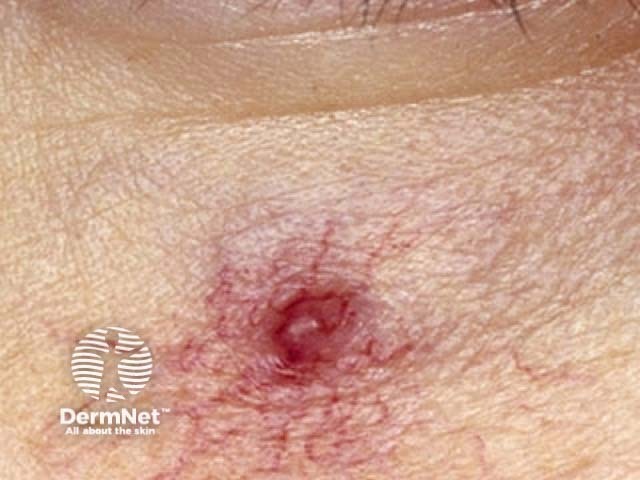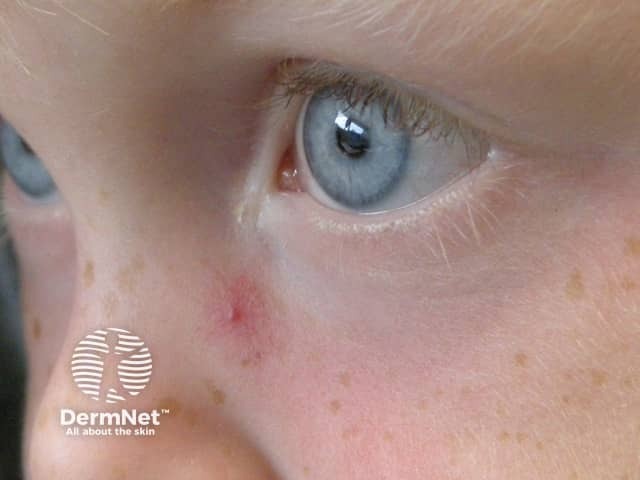Main menu
Common skin conditions

NEWS
Join DermNet PRO
Read more
Quick links
Author: A/Prof Amanda Oakley, Dermatologist, Hamilton, New Zealand. Copy edited by: Maria McGivern/Gus Mitchell. December 2017.
Introduction
Demographics
Causes
Clinical features
Diagnosis
Differential diagnoses
Treatment
Outcome
A spider telangiectasis (plural: telangiectases) is composed of dilated blood vessels, and is clinically characterised by its spider-like appearance. It is given that name because it has a central red papule (the body of the 'spider') from which fine red lines (the spider legs) extend radially. An alternative explanation for the name explains that the red lines form a spider-like network. Other names for spider telangiectasis are spider angioma (a misnomer), spider naevus and naevus araneus.



See more images of spider telangiectasis.
A solitary spider telangiectasis is common in children and adults, affecting 10–15% of the population. Although they can affect people of any race, spider telangiectases are more easily seen in fair skin compared to skin of colour. Multiple spider telangiectases arise most frequently in pregnancy, in women taking a combined oral contraceptive pill, in patients with liver disease (particularly, in cirrhosis due to alcohol abuse), and in those with thyrotoxicosis.

Telangiectases in patient with liver cirrhosis
Spider telangiectasis is an acquired vascular malformation. It occurs because of the failure of a tiny muscle restricting the size of an arteriole. Increased pulsating flow through the vessel (the central papule) results in the dilatation of distal vessels (the red lines).
Spider telangiectasis may arise spontaneously or may be induced by circulating oestrogen, which is increased in pregnancy, women taking combined oral contraceptives, and in those with liver disease. Various vascular endothelial growth factors may be involved.
Spider telangiectases are often located on the face, neck, and upper chest (this has been postulated to relate to the distribution of a large vein draining the heart, the superior vena cava). Spider telangiectases may also occur on the hands, arms, or other sites. Spider telangiectases vary in size and number, tending to be larger and more numerous in people with severe liver disease when other cutaneous signs of liver disease may be present such as palmar erythema, leukonychia, and jaundice. A central dilated arteriole may be present without radial capillaries, and the capillaries may vary in diameter, length, and number. They can also be star-shaped.
The lesions may briefly bleed on trauma but otherwise do not cause any symptoms or complications.
A spider telangiectasis is diagnosed by its typical appearance. Compression of the central arteriole results in the disappearance of the radial capillaries, which rapidly refill when the compression is relieved. This is best seen through a transparent object, such as a glass slide or the lens of a contact dermatoscope.
To aid in your differential diagnosis, see DermNet's pages on angioma and telangiectasia.
Spider telangiectases are distinct from 'spider veins', which are blue-coloured dilated venules arising on the thighs and lower legs and often associated with varicose veins.
A spider telangiectasis is harmless and does not require treatment. A lesion that is unsightly can be removed by destroying the feeding central arteriole, but this may result in a small scar. Treatments to remove spider telangiectasis include:
Surgical excision is rarely necessary and inevitably leaves a scar.
Spider telangiectases can persist or disappear. In women, oestrogen-induced telangiectases often disappear within 6 months after having a baby or of stopping the combined contraceptive pill. They can also reappear after initially successful treatment.